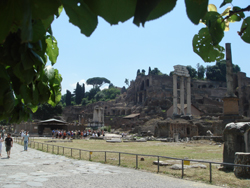-
 Brandenburg
Gate - One time the symbol not only of a divided
Berlin but of a divided Germany, the Brandeburg Gate
is now accesible to both East and West Berliners and
East and West Germans as a Unified City and a Unified
Nation.
Brandenburg
Gate - One time the symbol not only of a divided
Berlin but of a divided Germany, the Brandeburg Gate
is now accesible to both East and West Berliners and
East and West Germans as a Unified City and a Unified
Nation.Now, accessible to all, the Brandburg Gate is not only a major attraction but remains a mjaor symbol of the triumph of hope over the oppression of peoples by Communist regimes.
-
Siegessäule (Berlin Victory Column) - Right in the centre of the Tiergarten, the Siegessäule was originally intended to mark the victory of Prussia in the Prussian-Danish war in 1863. By the time it was completed, however, Prussia had also won the Austro-Prussian war and the Franco-Prussian war. These successes prompted the addition of 8.3 meter high, 35 tonne statue of Victoria, the Roman Goddess of Victory, to the top of the tower.
-
Berliner Cathedral - Damaged during the Second World War, the roof of the Berliner Dom had to be rebuilt and subsequent modifications and simplifications were made during the time of the German "Democractic" Republic. Climb the dome for fabulous views of the ornate interior and close up views of the dome decorations themselves.
-
Gendarmenmarkt - The Gendarmenmarkt is a square in central Berlin which is home to the Französische Dom, Deutsche Dom and Konzerthaus. The square is named after the Cuirassier regiment Gens d'Armes which was stationed at the square until 1773.
-
 Checkpoint
Charlie - Right on Friedrichstraβe, Checkpoint
Charlie is one of the most iconic images of the Cold
War period - both in Berlin and beyond. Today, all the
original parts of Checkpoint Charlie, the only crossing
point open to foreigners, have been removed. It has,
however, been repalced with a replica "soldier box" complete
with sandbags, Soviet-ear peack caps and actor-soldiers
for pictures at a couple Euros a pop. Nearby an informative
new wall outlines the history of Communism in Eastern
Europe
and the role played by the Berlin Wall.
Checkpoint
Charlie - Right on Friedrichstraβe, Checkpoint
Charlie is one of the most iconic images of the Cold
War period - both in Berlin and beyond. Today, all the
original parts of Checkpoint Charlie, the only crossing
point open to foreigners, have been removed. It has,
however, been repalced with a replica "soldier box" complete
with sandbags, Soviet-ear peack caps and actor-soldiers
for pictures at a couple Euros a pop. Nearby an informative
new wall outlines the history of Communism in Eastern
Europe
and the role played by the Berlin Wall. -
Schloss Charlottenberg - The largest palace in Berlin city - Schloss Charlottenberg. Built in the 17th by Sophie Charlotte (wife of Friedrich III, Elector of Brandenburg.) The Palace was originally known as Lietzenburg but was renamed Charlottenburg by Friedrich I (who had crowned himself King of Prussia) following the death of Sophie Charlotte in 1705. Charlottenburg was the original location of The Amber Room which was gifted to the Tsar Peter the Great to 1716 but has been missing since the last years of World War II. Extensive renovations were after The War saw the reconstruction of the Baroque and Rococo styles thoughout the Palace.
-
Museum Insel - The northern section of an island in the middle of the River Spree in central Berlin is renowned for its internationally recognised museums including the Altes Museum, the Neues Museum, Altes Nationalgalerie, Bode Museum and the Pergamon Museum. In 1999, the Island was added to the UNESCO list of World Heritage Sites.
-
 Potsdamer
Platz - The Berlin Wall once ran directly through
Potsdamer Platz and, appropriately, parts of the wall
remain in the Square. Now the square forms a vibrant
hub of commericalness with several restaurants and bars in the surrounding area.
Potsdamer
Platz - The Berlin Wall once ran directly through
Potsdamer Platz and, appropriately, parts of the wall
remain in the Square. Now the square forms a vibrant
hub of commericalness with several restaurants and bars in the surrounding area. -
Fernsehturm - The Fernsehturm (Television Tower) is one of the most prominent and notable landmarks of Berlin - visible from nearly everywhere. Built in 1969, the Fernsehturm quickly exhibited "The Popes Revenge" - a phenonomen whereby light shining on the stainless steel dome a reflection in the shape of a Crucifix was visible. The German "Democratic" Republic made numerous efforts to combat this undesired effect but to no avail. Taking the elevator up to the viewing platform and cafe / restaurant offers fine views over the whole city.
River Cruise - taking a river cruise is an old-favorite way to see many of the sites of a city from a different angle. With over 30 different tours covering the Spree River, the canal, Havel River and the city itself there's probably a tour for you - check the Visit Berlin website for more options.
-
Reichstag - Now home to the paliament of the reunited Germany. Renowned architect Norman Foster won the the competition for the reconstruction of the building in 1992 - and finally completed the process in 1999 after which the Parliament and Government moved from Bonn. The dome affords 360-degree views over the Berlin skyline but is only accessible by prior registration.







